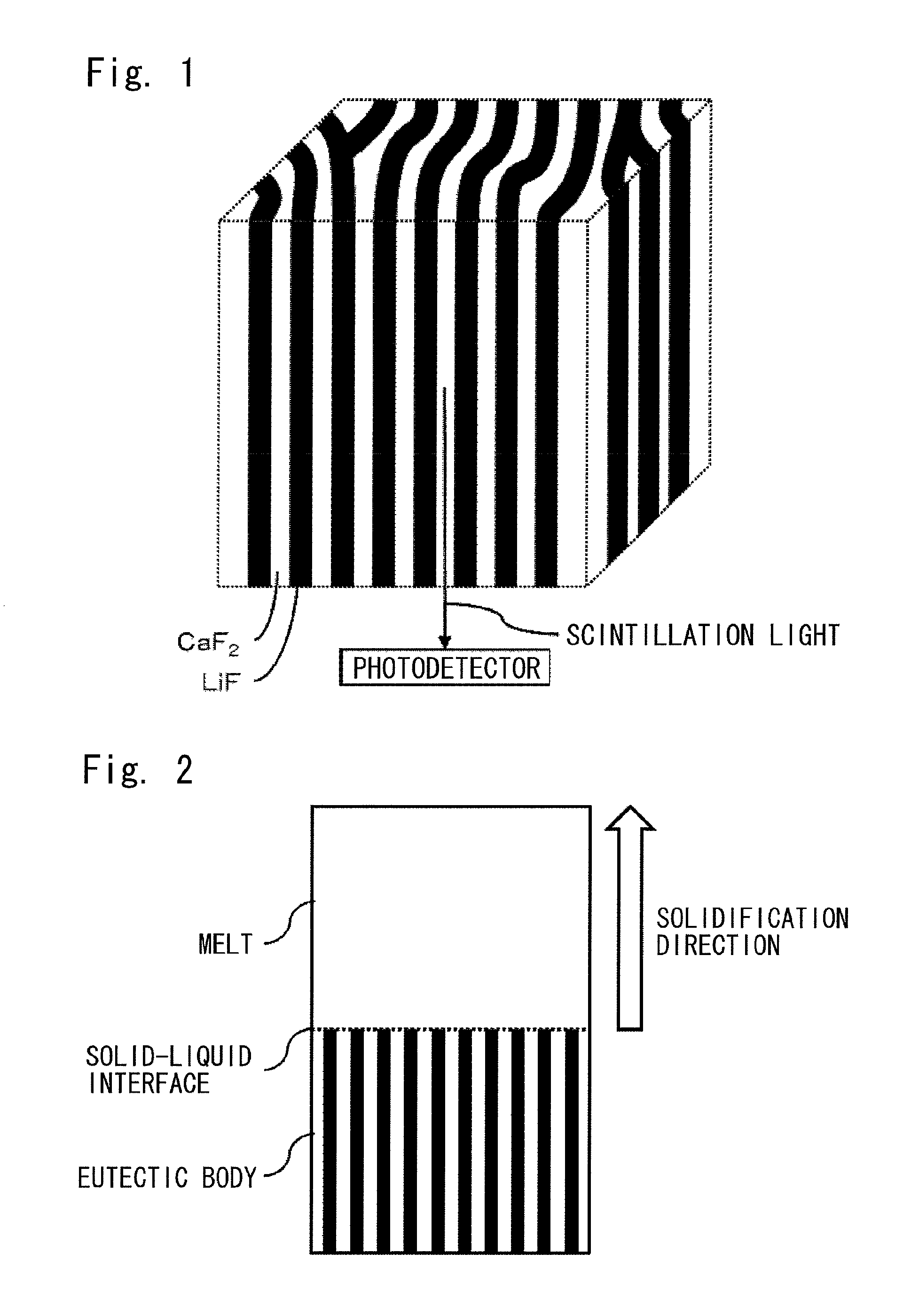Neutron scintillator and neutron detector
a neutron detector and scintillator technology, applied in the field of neutron scintillators, can solve the problems of limited count rate, so-called background noise increase, and high cost of helium-3, and achieve excellent n/ discrimination ability and high neutron detection efficiency
- Summary
- Abstract
- Description
- Claims
- Application Information
AI Technical Summary
Benefits of technology
Problems solved by technology
Method used
Image
Examples
example 1
Production of Eutectic Body
[0069]Lithium fluoride (331 g), calcium fluoride (258 g), and europium fluoride (3.45 g), as starting materials, were mixed to prepare a material mixture. Each starting material used was a powder with purity of 99.99% or more. As lithium fluoride, a material having a 6Li-isotope ratio of 95% was used. The component ratio between lithium fluoride and calcium fluoride in the material mixture was 0.8 mol lithium fluoride: 0.2 mol calcium fluoride, and the amount of europium, as a luminescence center element, contained in CaF2 crystals was 0.5 mol % with respect to CaF2.
[0070]Then, the material mixture was charged into a crucible formed of carbon and having an internal diameter of 60 mm, and the crucible was installed in a chamber equipped with a resistance heating type heater, a heat insulator, and a vacuum evacuator. Using the vacuum evacuator, the interior of the chamber was evacuated to 2.0×10−4 Pa or lower. Then, a high purity argon gas mixed with 5 vol %...
example 2
Production of Eutectic Body
[0083]A eutectic body was obtained in the same manner as in Example 1, except that the solidification rate was set at 3 mm / hr. The resulting eutectic body was observed for a compositional backscattered electron image in the same manner as in Example 1. A compositional backscattered electron image of a surface of the eutectic body when cut in a direction parallel to the solidification direction is shown in FIG. 7. A compositional backscattered electron image of a surface of the eutectic body when cut in a direction perpendicular to the solidification direction is shown in FIG. 8.
[0084]FIG. 7 shows that CaF2 crystal layers were linearly continuous in one direction. In connection with the compositional backscattered electron image of FIG. 8, the thickness of the LiF crystal layer was measured using the length measuring function of the SEM. The thickness of the layer of LiF in the eutectic body was found to be 4 μm. Powder X-ray diffraction measurement was per...
preparation example 2
Preparation and Characteristics Evaluation of Neutron Detector
[0086]The response characteristics of the neutron scintillator (i.e., response to neutrons) were evaluated in the same manner as in Example 1. FIG. 6 shows a pulse height spectrum obtained when the neutron scintillator of Preparation Example 1 was used. FIG. 9 shows, and compares, pulse height spectra obtained when the neutron scintillators of Preparation Example 1 and Preparation Example 2 were used.
[0087]Clear peaks indicating the detection of neutrons were confirmed from FIG. 6. Thus, it has been found that the eutectic body of the present invention acts effectively as a neutron scintillator, and that a neutron detector using the neutron scintillator is effective. As in Example 1, the peaks showing the detection of neutrons can be clearly distinguished from gamma-ray noises. Hence, the neutron scintillator of the present invention has been found to have excellent n / γ discrimination ability.
[0088]The pulse height spectr...
PUM
 Login to View More
Login to View More Abstract
Description
Claims
Application Information
 Login to View More
Login to View More - R&D
- Intellectual Property
- Life Sciences
- Materials
- Tech Scout
- Unparalleled Data Quality
- Higher Quality Content
- 60% Fewer Hallucinations
Browse by: Latest US Patents, China's latest patents, Technical Efficacy Thesaurus, Application Domain, Technology Topic, Popular Technical Reports.
© 2025 PatSnap. All rights reserved.Legal|Privacy policy|Modern Slavery Act Transparency Statement|Sitemap|About US| Contact US: help@patsnap.com



